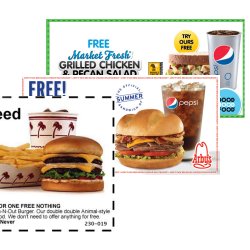 It is a standard piece of advice: use coupons to save money. And many businesses mail out coupons to potential customers every month to bring them into the stores and restaurants. Coupons, sales, and discounts are necessary competitive advantages for businesses who rely on “walk-in” traffic; if your customers put you on retainer you are not motivated to provide them with competitive offers and discounts.
It is a standard piece of advice: use coupons to save money. And many businesses mail out coupons to potential customers every month to bring them into the stores and restaurants. Coupons, sales, and discounts are necessary competitive advantages for businesses who rely on “walk-in” traffic; if your customers put you on retainer you are not motivated to provide them with competitive offers and discounts.
Among the businesses most hard hit by consumer saving frenzies are the restaurants. And though conventional wisdom suggests that many consumers may prefer fast food in hard times because it is “cheap and convenient”, the truth is that fast food meals can be very expensive. If you are accustomed to eating large meals, for example, then you may buy two fast food meals instead of one; or you order an extra burger, an extra hash brown, etc.
And so consumers may be wary of eating fast food simply because fast food can be so expensive. But there is the health concern as well. Fast food is often fried, full of sugar and salt, and uses low-quality ingredients in many mass-produced food items (chicken nuggets are often called out for including nearly every part of the chicken, including bones).
Combine the high costs of eating in terms of both money and health risks, and consumers are less likely to spend their money at the local burger joint. And so the restaurants make their menus more appealing by offering coupons, specials-of-the-day, and other incentives to bring in more customers.
Should we go for it? Should we save money but put our health at risk? Well, you may be able to save money and improve your eating habits at the same time. You just have to be selective about which restaurants you patronize.
For example, can you use the coupon but substitute a side salad for fries? Fast food salads are not exactly high on dieticians’ list of preferred foods (especially if they are laden with sugary dressings and American cheese process food). But given a choice between eating lettuce with tomatoes and a soy-based Ranch dressing or a large fry, the average dietician is going to suggest you trade the fries for a salad.
Fast food is also unhealthy because it comes with so much bread, but this is true of any restaurant that serves complementary breadsticks and rolls. So if you’re saving a dollar by eating a double-burger at the local drive-thru, consider asking them to hold the bread. You can toss those beef patties onto your salad and at least cut down on fried foods and excess carbohydrates.
In fact, according to some protein dieting Websites, this is a great meal plan. By making better choices with your fast food meals you at least reduce the amount of unnecessary calories and fried fats you consume; and you can still save money.
Good couponing tip Websites also suggest that you plan ahead by using calendars and portfolios. This may require extra time out of your day but in the end you’ll be better able to watch where your money goes. By creating a spreadsheet to plan your fast food meals, you can show yourself what coupons you used, how much you spent, and what foods you ate. You’ll organize coupons, track spending, and watch calories and high fat foods all at the same time.
Fast food restaurants now offer many better foods than they used to. You can often buy baked or grilled alternatives (especially in chicken) to their regular fried menu items. And some fast food restaurants offer full-sized salads packed with good ingredients. The cheese process food may be optional.
Cutting down on the sugary additives and fried foods is important for your health but that doesn’t mean you have to give up the fast food experience altogether. If your daily workplace lunch is crowded with fast food options you may be able to save money by using coupons and keep your waisteline under control by cherry-picking the healthiest options available.
